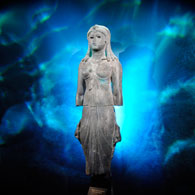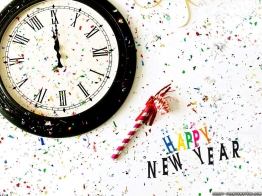I may not have had the opportunity to go anywhere truly spectacular this summer, but last month my friends and I did take a trip to the California Science Center (arguably one of the coolest interactive museums around here, along with the one at the La Brea Tar Pits – but still nothing beats the International Spy Museum…I so want to go back there…).
Anyway, we went to the Science Center to see the new Cleopatra exhibit (which you can find details about here), and I have to say, it was pretty cool.
First we stood in line outside the exhibit and this funny dude dressed as a Greek soldier spoke to us in what we could only presume was Latin and identified us by our clothing/jewelry. One of my friends was wearing a cross necklace – she was deemed a torture-worshiper. My other friend was accurately identified as German, and because she was wearing a dark gray shirt, the guy commented that she wore ashes as her ancesters had, or something of that nature. I happened to not only be wearing my favorite dolphin necklace, but I was also wearing a t-shirt with an anchor on it, so I was identified as a worshiper of Neptune, god of the sea. I thought it was rather appropriate.
 Once we were allowed inside, we were corralled in this little theater where we watched a brief video about Cleopatra and how two archaeologists (one making his discoveries in the desert, the other beneath the ocean) came to collect all of the exhibit’s artifacts. Once the movie was over the screen pulled up dramatically and a statue of Cleopatra was lit up behind it with lighting and sound effects that made it look as though it were under water. It was really impressive. So impressive that I didn’t even think to take a picture. (This one was snagged from the Science Center’s website.) I highly recommend seeing the exhibit just for that opening!
Once we were allowed inside, we were corralled in this little theater where we watched a brief video about Cleopatra and how two archaeologists (one making his discoveries in the desert, the other beneath the ocean) came to collect all of the exhibit’s artifacts. Once the movie was over the screen pulled up dramatically and a statue of Cleopatra was lit up behind it with lighting and sound effects that made it look as though it were under water. It was really impressive. So impressive that I didn’t even think to take a picture. (This one was snagged from the Science Center’s website.) I highly recommend seeing the exhibit just for that opening!
Anyway, once we started exploring the exhibit I actually remembered I had a camera (or rather an ipod, since my brother still had my memory card) so now I shall share with you some of the pictures.
 I was really impressed with these statues. They were HUGE! The lighting in here wasn’t good for a human-to-statue comparison of their size, but you can see part of a person outlined against the red sign in the bottom left corner – that should give you some idea. They were roughly two stories tall! Both of these statues were recovered from the Egyptian coast in what used to be part of Cleopatra’s kingdom (I believe these were found in what used to be Heracleion). The statue on the right is Cleopatra, and the one on the left is, I believe, her brother. I can’t remember if she eventually married him or not… It got really confusing after a while. Egyptians didn’t have any qualms about marrying siblings, or their own children, so naturally a lot of them were a little on the odd side and tracing anyone’s lineage in that time period could easily give you a headache.
I was really impressed with these statues. They were HUGE! The lighting in here wasn’t good for a human-to-statue comparison of their size, but you can see part of a person outlined against the red sign in the bottom left corner – that should give you some idea. They were roughly two stories tall! Both of these statues were recovered from the Egyptian coast in what used to be part of Cleopatra’s kingdom (I believe these were found in what used to be Heracleion). The statue on the right is Cleopatra, and the one on the left is, I believe, her brother. I can’t remember if she eventually married him or not… It got really confusing after a while. Egyptians didn’t have any qualms about marrying siblings, or their own children, so naturally a lot of them were a little on the odd side and tracing anyone’s lineage in that time period could easily give you a headache.

 I really liked both of these statues. They weren’t particularly large like the giant sphinx that everyone is familiar with, but they were still pretty cool.
I really liked both of these statues. They weren’t particularly large like the giant sphinx that everyone is familiar with, but they were still pretty cool.
I couldn’t read the sign next to these properly because people were in my way, but I believe the heads might depict Cleopatra and her brother. Or her/their children…or maybe they don’t depict anyone in particular.
I spent most of my time in this part of the exhibit listening to the audio recording and trying to read all the signs, which you can’t quite do at the exact same time, so it made things a little tricky. My brain isn’t particularly hard-wired for history facts, but I can tell you some random fun facts. For one thing, around this time there was a lot of Greek influence in Egypt (hence the Greek soldier at the beginning of our tour). The Egyptian gods before now had often been depicted with animal heads, but with the Greek influence, they began to look more human. The Egyptians really liked some of the Greek gods (like Dionysus – a god you can worship by drinking and partying? Drinks all around!) so they adopted them as their own, and others became hybrids between Greek gods and Egyptian gods. Also, the Egyptians considered their rulers to be gods so once someone (like Cleopatra) ascended the throne, there was also a ceremony in which he/she became the embodiment of a certain god. For Cleopatra, that god was Isis. I couldn’t get any decent quality pictures with my ipod but there were these really cool little figurines that depicted Cleopatra as Isis.
Of course, any exhibit of an Egyptian queen would be incomplete without a look at her jewelry:
Fun fact about the Egyptian beauty regimen: you know that black stuff they paint around their eyes? It wasn’t just a fashion statement. They actually wore that stuff to keep pesky desert flies away from their eyes. Pretty cool, huh?
 Cleopatra actually had a deep intellectual interest in women’s health. Though she wrote books/scrolls on makeup and other beautification practices, she also was well-studied in medicine and had an in-depth knowledge of poisons. In fact, as the story goes, when she committed suicide to save herself the shame and embarrassment and mockery of being captured after her kingdom was overthrown, she purposefully chose the bite of an adder (snake) because it would send her into a deep sleep before eventually killing her.
Cleopatra actually had a deep intellectual interest in women’s health. Though she wrote books/scrolls on makeup and other beautification practices, she also was well-studied in medicine and had an in-depth knowledge of poisons. In fact, as the story goes, when she committed suicide to save herself the shame and embarrassment and mockery of being captured after her kingdom was overthrown, she purposefully chose the bite of an adder (snake) because it would send her into a deep sleep before eventually killing her.
Oh, right, skipped a lot there – see, among unfortunate arrangements such as marrying relatives in order to maintain control/a right to the throne, Cleopatra was still human and fell in love. The most notable of her love affairs is that with Mark Antony. The details got a little jumbled since I seemed to have navigated the signs and recordings in somewhat of a backwards order at this point in the exhibit tour, but the gist of it is there was this huge war because two guys were in love with Cleopatra: Mark Antony and this other guy I sadly cannot remember the name of…was it Julius Ceaser? I think it was him…yeah, it was him – he had had a child with Cleopatra (Caesarion) but then totally disowned him and didn’t want to have anything to do with him, and by disowning his own son, he prevented Cleopatra from having any control over Julius Ceaser’s empire.
Anyway, both men were in love with her, but Cleopatra favored Mark Antony, so obviously Julius didn’t like that very much. War broke out, and Julius spread a rumor that Mark Antony was dead. It wasn’t exactly true at the time, but, communication being ancient as it was, Cleopatra didn’t know that, and Mark Antony had thought that Cleopatra was dead for some reason, so there was this whole Romeo/Juliet suicide confusion. Anyway, Mark Antony died in Cleopatra’s arms, and, facing imminent capture, Cleopatra went back to her chambers and allowed herself to be bit by an adder.
Part of the reason that there aren’t many records of Cleopatra’s image or any documentation of what she was really like is because after this, Julius Ceaser ceased control and made absolutely certain that Cleopatra was erased from history as much as possible. There were a few statues in the exhibit that were headless. It is believed they once depicted Cleopatra (who was said to be incredibly beautiful) but Julius had the heads and faces of any statues/paintings/carvings removed. To make doubly sure that Cleopatra would have no glory to her name after her death, he had his historians rewrite everything about her, depicting her as nothing more than a sexy minx who seduced her way to power. Though she had many lovers, this is far from the truth as she was in fact very cunning and had a great deal of knowledge when it came to military tactics. She was actually able to maintain peace for quite a while during her reign because of her wisdom. She had total girl power without her sexuality. One could say it was her sexuality that led to her downfall, but in truth it was men trying to solve their problems with war. Silly boys…
What has been discovered about Cleopatra so far (and thus displayed in the exhibit) is slowly telling us the truth about her story, and how totally bad-ass she was. Though her real tomb hasn’t been discovered yet (just a fake tomb and remnants of her empire), archaeologists feel that they are getting closer to discovering its whereabouts. It’s kind of like a giant book that’s got a few pages missing, and a few pages with writing all over them telling lies, and the archaeologists are trying to figure out what happened in the original story.






